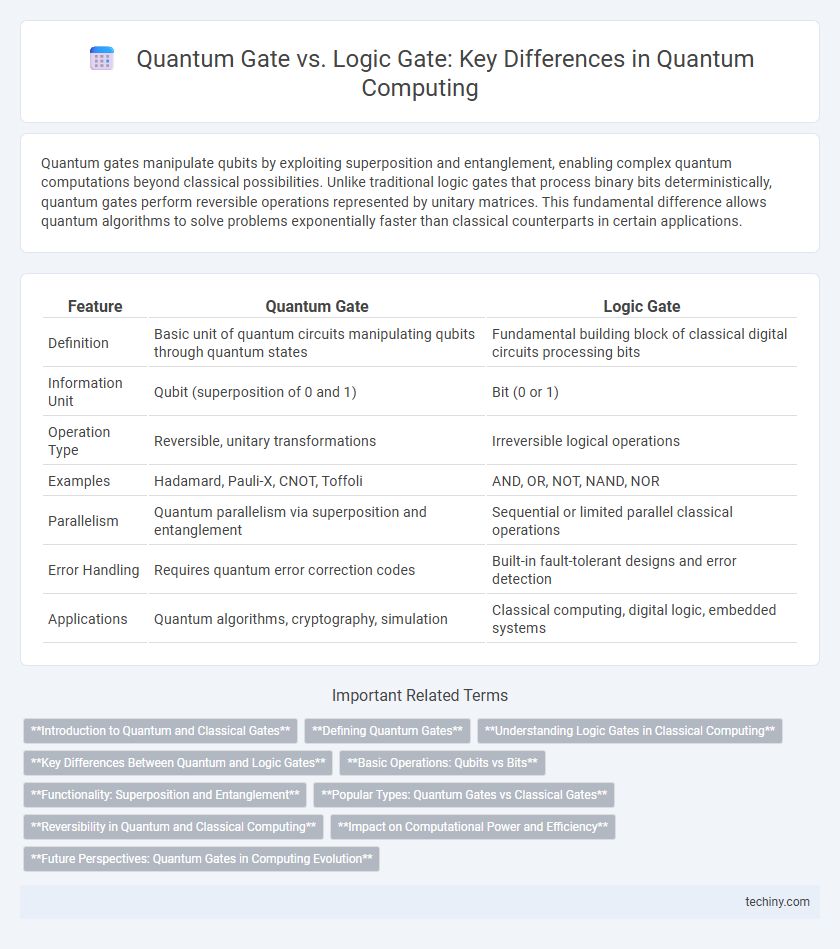Quantum gates manipulate qubits by exploiting superposition and entanglement, enabling complex quantum computations beyond classical possibilities. Unlike traditional logic gates that process binary bits deterministically, quantum gates perform reversible operations represented by unitary matrices. This fundamental difference allows quantum algorithms to solve problems exponentially faster than classical counterparts in certain applications.
Table of Comparison
| Feature | Quantum Gate | Logic Gate |
|---|---|---|
| Definition | Basic unit of quantum circuits manipulating qubits through quantum states | Fundamental building block of classical digital circuits processing bits |
| Information Unit | Qubit (superposition of 0 and 1) | Bit (0 or 1) |
| Operation Type | Reversible, unitary transformations | Irreversible logical operations |
| Examples | Hadamard, Pauli-X, CNOT, Toffoli | AND, OR, NOT, NAND, NOR |
| Parallelism | Quantum parallelism via superposition and entanglement | Sequential or limited parallel classical operations |
| Error Handling | Requires quantum error correction codes | Built-in fault-tolerant designs and error detection |
| Applications | Quantum algorithms, cryptography, simulation | Classical computing, digital logic, embedded systems |
Introduction to Quantum and Classical Gates
Quantum gates manipulate qubits using principles of superposition and entanglement, enabling complex operations beyond classical logic gates' binary functions. Classical logic gates like AND, OR, and NOT process bits as definite states of 0s and 1s, following Boolean algebra. Quantum gates, represented by unitary matrices, perform reversible transformations crucial for quantum algorithms and error correction.
Defining Quantum Gates
Quantum gates are fundamental building blocks of quantum circuits, manipulating qubits through unitary transformations that preserve quantum coherence. Unlike classical logic gates operating on binary bits, quantum gates utilize superposition and entanglement to perform complex computations with quantum states. Key examples include the Hadamard gate, which creates superposition, and the CNOT gate, enabling entanglement essential for quantum algorithms.
Understanding Logic Gates in Classical Computing
Logic gates in classical computing are fundamental building blocks that perform basic Boolean operations such as AND, OR, and NOT on binary inputs to produce a single binary output. These gates manipulate bits, representing either 0 or 1, enabling the execution of digital circuits and complex computational tasks. Unlike quantum gates, which operate on qubits using superposition and entanglement principles, classical logic gates rely on deterministic binary states for information processing.
Key Differences Between Quantum and Logic Gates
Quantum gates operate on qubits using superposition and entanglement, enabling parallelism that classical logic gates cannot achieve with binary bits. Unlike irreversible classical logic gates, quantum gates are reversible and represented by unitary matrices, preserving information throughout computation. The probabilistic nature of quantum gates allows complex quantum algorithms, while conventional logic gates perform deterministic operations based on Boolean algebra.
Basic Operations: Qubits vs Bits
Quantum gates manipulate qubits, enabling superposition and entanglement, which allow multiple states to be processed simultaneously. Classical logic gates operate on bits with definitive binary values, performing simple deterministic operations like AND, OR, and NOT. The fundamental difference lies in quantum gates' ability to perform complex linear transformations on qubit states represented by vectors in Hilbert space, whereas logic gates conduct straightforward binary Boolean algebra on bits.
Functionality: Superposition and Entanglement
Quantum gates manipulate qubits by exploiting superposition and entanglement, enabling multiple states to be processed simultaneously for complex quantum algorithms. Unlike classical logic gates that perform deterministic binary operations on bits, quantum gates use unitary transformations to maintain coherence and enable probabilistic outcomes. This fundamental difference in functionality allows quantum gates to solve certain computational problems exponentially faster than classical logic gates.
Popular Types: Quantum Gates vs Classical Gates
Popular quantum gates such as the Hadamard, Pauli-X, and CNOT manipulate qubits through superposition and entanglement, enabling complex quantum operations that classical gates cannot perform. Classical logic gates like AND, OR, and NOT process binary bits deterministically, forming the foundation of traditional digital circuits. Quantum gates operate on quantum states with reversible and unitary transformations, while classical gates implement irreversible Boolean functions on definite states.
Reversibility in Quantum and Classical Computing
Quantum gates are inherently reversible, described by unitary matrices that preserve quantum information without loss, enabling backward computation and error correction. Classical logic gates like AND or OR are typically irreversible, causing information loss and energy dissipation according to Landauer's principle. This fundamental difference highlights quantum computing's ability to perform computations with minimal heat generation and preserves coherence, essential for effective quantum algorithms.
Impact on Computational Power and Efficiency
Quantum gates leverage superposition and entanglement to perform complex calculations exponentially faster than classical logic gates, enabling quantum algorithms to solve problems deemed intractable for classical computers. Unlike traditional logic gates that process binary inputs sequentially, quantum gates manipulate qubits simultaneously, drastically improving computational efficiency and parallelism. This fundamental advancement enhances the potential for breakthroughs in cryptography, optimization, and simulation of quantum systems, outperforming classical approaches in both speed and resource utilization.
Future Perspectives: Quantum Gates in Computing Evolution
Quantum gates leverage the principles of superposition and entanglement, enabling exponentially faster processing capabilities compared to classical logic gates confined to binary states. The evolution of quantum gates promises transformative advances in cryptography, optimization, and artificial intelligence by harnessing quantum parallelism. Future quantum computing architectures will integrate scalable quantum gate arrays to overcome current hardware limitations and accelerate practical quantum advantage realization.
Quantum Gate vs Logic Gate Infographic

 techiny.com
techiny.com